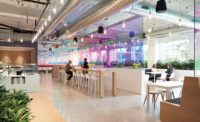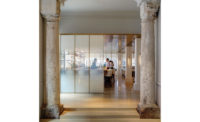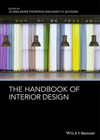Shanghai Office of Horizon Design Company
Best Preservation Project

Shanghai Office of Horizon Design Company
Photo © Jim Chang and Steve Mok

Shanghai Office of Horizon Design Company
Photo © Jim Chang and Steve Mok

Shanghai Office of Horizon Design Company
Photo © Jim Chang and Steve Mok

Shanghai Office of Horizon Design Company
Photo © Jim Chang and Steve Mok

Shanghai Office of Horizon Design Company
Photo © Jim Chang and Steve Mok





J.J. Pan & Partners
Shanghai, China
An American-trained Taiwanese architect, Joshua Pan is best known for the large building complexes and tall skyscrapers he has designed since establishing J.J. Pan & Partners in Taipei in 1981. In 2000, Pan expanded his firm to mainland China, establishing Horizon Design as his mainland subsidiary. To accommodate his growing staff there, he acquired an old industrial building in the Yangpu district of Shanghai and converted it into offices for Horizon Design. “The intent was to keep the integrity and memory of the past, while furnishing it with a touch of modernity in form and function,” says the architect.
The building, which was the first General Electric factory in Asia when it opened in 1921, served as a Japanese arsenal during the 1930s. It sits near the Huangpu River and is part of a complex of factories and warehouses built for the Shanghai Power Station Auxiliary Equipment Company. While most people today recognize the importance of restoring the grand office buildings on the Bund, not everyone understand the need to preserve parts of Shanghai’s industrial heritage. But Pan, who had apprenticed with Philip Johnson in New York in the 1960s and ’70s when Johnson was beginning to explore ways of using history in his work, saw the beauty of the old factory.
To retain the character of the old building, he and his team did as little to the exterior as possible, even keeping chipped surfaces and old paint. “I think that it’s important to be able to work on something and keep the historical appearance of it,” says Pan. The architects kept the existing steel frame of the entry canopy, but built a new roof over it using a combination of dry reeds and translucent fiber-reinforced polycarbonate panels to create a play of light and shadow. For the main door, they restored the cast-iron original and added Horizon’s bold red-and-black logo to it. And for paving at the entryway, they used iron planks found during excavation on the site.
Inside the old factory, Pan and his colleagues inserted two structures: a large glass box enclosing the workstations and an elliptical conference room made of bricks salvaged from buildings demolished in Shanghai. The work area and the conference room are the only climate-controlled areas in the office. The extensive use of recycled materials and the minimization of air-conditioning help make this project an interesting exercise in eco-friendly design. “It’s good to keep the flavor of the old building, but we have to be practical as to how people use the space,” explains Pan.
Throughout the interior, the architects offset the roughness of the original building finishes with sleek new materials such as glass and steel. They also tried to mix public spaces with more private ones, echoing the urban pattern found in the streets and plazas of old Shanghai. Above the workstations, Pan and his team inserted a mezzanine that can be used as exhibition space. In one corner of the building, they created an open library and casual coffee area raised several steps above the main floor. The cylindrical conference room faces the library and can turn into the stage of an indoor amphitheater when one of its curving walls slides out of the way and employees sit on the steps. “We try to double- and even triple-program spaces so they can be rearranged and used in different ways,” says Pan.
Explaining his design methodology, Pan says, “I try to incorporate indigenous or local character into the modern international style buildings.”





